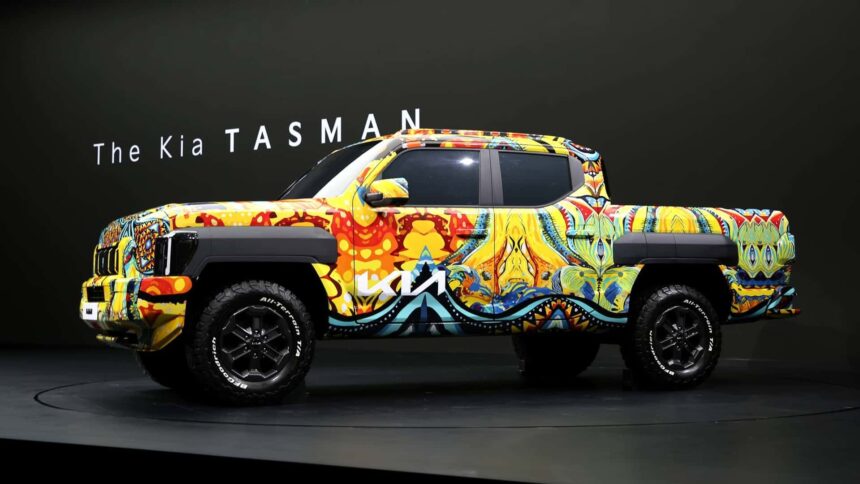Kia has surprised everyone by showcasing its first global pickup, the Tasman, at the 2024 Busan Motor Show in South Korea. While the truck won’t be available for purchase until later in 2025, Kia has given us a sneak peek at what to expect from this mid-size contender.
The Tasman is presented in a vibrant livery designed by artist Richard Boyd-Dunlop, drawing attention to its unique features. The truck sports plastic cladding around square wheel arches, vertical headlights, tow hooks, disc brakes on all corners, and 17-inch wheels wrapped in BF Goodrich All-Terrain T/A tires. Despite the absence of calipers and suspension components, the design is finalized, showcasing tiny cameras below the side mirrors for blind-spot monitoring.
The rear bumper of the Tasman features integrated steps for easy access to the bed, which appears to be of decent size. The rear end boasts small taillights and a split tailgate, while the windows are tinted to conceal the interior. However, a video published on TikTok has already revealed the cabin weeks before the official debut.
While Kia has not disclosed details about the engines, reports suggest a 2.2-liter turbodiesel four-cylinder engine will be available in both 4×2 and 4×4 configurations with an eight-speed automatic transmission. There is speculation about the potential inclusion of a V-6 engine to compete with rivals like the Volkswagen Amarok and Toyota Hilux.
In terms of capabilities, the Tasman is expected to offer a payload capacity of around 2,200 pounds and towing capacity of up to 7,700 pounds. Moreover, an all-electric variant is rumored to be in development for a launch in late 2026. While the Tasman will not be Kia’s only body-on-frame vehicle, alongside the Mohave/Borrego, its future remains uncertain.
The Tasman is positioned as a mid-size truck larger than the Ford Ranger but smaller than the F-150. Kia has initially showcased the dual cab body style, but there are hints of a single cab and chassis cab models in the pipeline.
Although the Tasman has been spotted testing in the United States, it is unclear whether it will be available in the market. However, a separate fully electric pickup from Kia has also been captured testing in the US, hinting at the brand’s commitment to expanding its lineup with innovative offerings. The world of technology is constantly evolving, with new innovations and advancements being made every day. From smartphones to self-driving cars, there seems to be no limit to what technology can achieve. One of the latest developments in the tech world is the rise of artificial intelligence (AI) and machine learning.
AI and machine learning are revolutionizing the way we interact with technology. These technologies are allowing computers to learn from data and make decisions without being explicitly programmed. This has opened up a whole new world of possibilities, from personalized recommendations on streaming services to autonomous vehicles that can navigate traffic on their own.
One of the most exciting applications of AI and machine learning is in the field of healthcare. These technologies are being used to analyze large amounts of medical data to help diagnose diseases and develop personalized treatment plans. AI-powered medical imaging systems are able to detect abnormalities in X-rays and MRIs with a high degree of accuracy, allowing doctors to make more informed decisions about patient care.
In addition to healthcare, AI and machine learning are also being used in a variety of other industries. In finance, these technologies are being used to detect fraudulent activity and make more accurate predictions about stock prices. In manufacturing, AI-powered robots are being used to automate tasks that were once done by humans, increasing efficiency and reducing costs.
Despite the many benefits of AI and machine learning, there are also concerns about the ethical implications of these technologies. For example, there are concerns about bias in AI algorithms, which can lead to discriminatory outcomes. There are also concerns about the impact of automation on the job market, as more tasks become automated, leading to job losses in some industries.
Overall, the rise of AI and machine learning is an exciting development in the world of technology. These technologies have the potential to revolutionize industries and improve the lives of people around the world. However, it is important to proceed with caution and consider the ethical implications of these technologies as they become more integrated into our daily lives. With the right approach, AI and machine learning have the potential to create a brighter future for all of us.







